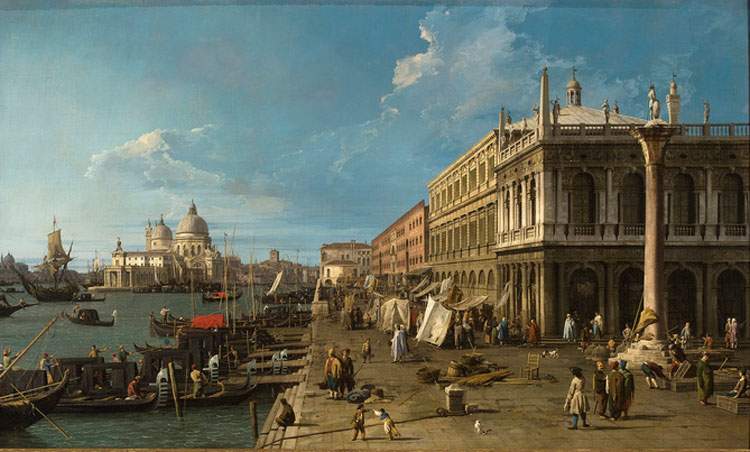From Aug. 6 to Oct. 24, 2021, the special guest of the Giorgio Franchetti Gallery at Ca’ d’Oro will be Canaletto ’s veduta depicting Il Molo verso ovest with the Zecca and the column of San Teodoro from the Civica Pinacoteca of the Castello Sforzesco in Milan. The loan is due to a temporary exchange between the two institutions on the occasion of the current exhibition Il Corpo e l’Anima da Donatello a Michelangelo. Italian Renaissance Sculpture, on display at Milan’s Castello Sforzesco until Oct. 24.
Canaletto’s painting is part of a pair of works made as pendants from the collections of Thomas Osborne, fourth Duke of Leeds: the painter’s painting, after several passages, arrived in the collection of Milanese senator Luigi Albertini, only to be purchased for the civic collections in 1995.
For Canaletto meets Guardi. Comparing Venetian Views: the Pier to the Basilica della Salute, Canaletto’s painting will be displayed alongside the painting of the same subject done by Francesco Guardi belonging to the Franchetti collection. The occasion allows for the juxtaposition of two Venetian views, placing in direct comparison two “still images” (and two different pictorial conceptions of the urban portrait) of absolute protagonists of 18th-century lagoon vedutismo: Canaletto’s luminous version, of broad scenographic scope and impeccable perspective coherence, referable to the painter’s maturity and datable within 1742, and Francesco Guardi’s vibrant lyrical interpretation at an advanced stage of his production.
The event takes place in celebration of the 1,600th anniversary of the founding of Venice.
Introduced by the column of St. Theodore, recalling the city’s origins and the cult of the Byzantine saint, the string of Marcian architecture facing the quay’s waterfront begins with the depiction of the south corner of Sansovinian’s Libreria, inspired by the models of ancient Rome, with the statues soaring to the crowning cornice completing its monumental layout. This is followed by the façades of the Zecca, in front of which the ancient fish and poultry market took place, the austere block of the Granai di Terranova, which housed the warehouses for storing grain, and, closing the fondamenta, the small building of the Fonteghetto della Farina, where the resale of the precious product of milling took place, which became the headquarters of the Accademia dei Pittori in the eighteenth century. Beyond the mouth of the Grand Canal is the Punta della Dogana with the majestic domes of Baldassarre Longhena’s Basilica della Salute, an imposing ex-voto built to save the city from the plague of 1630, and further in the distance, half-hidden by the sailing ship in Canaletto’s painting and better visible in Guardi’s layout, the other important building of worship linked to the terrible disease, Palladio’s Redentore della Giudecca.
On the shore and on the water, the daily life of the Serenissima unfolds, from the boats docking and unloading goods, to the market tents teeming with household goods, to the depiction of a heterogeneous, busy humanity; elegant ladies stroll on the foundations in Guardi’s painting, and then excerpts of Canaletto’s ’still life’ en plein air, such as that of the baskets and barrels with empty chair on the shore or like the group on the right with the gentleman from behind in tricorn and the three Levantines also taken up by Bernardo Bellotto in one of his canvases.
Prominent protagonists in both paintings are the light and the sky: a warm and enveloping Venice, congenial to the image of enchanting naturalness dear to the Enlightenment-derived rationalist taste in Canaletto’s canvas; a sentimental transfiguration with almost pre-Romantic tones in Guardi’s reinterpretation.
A specially created itinerary with the App izi.Travel will accompany visitors to explore the comparison between the two paintings, with the help of iconographic and topographical information that can be downloaded to their smartphones.
There will also be guided tours and routes departing from the Gallery and the exhibition to the places visible in the 18th-century canvases.
Pictured, Canaletto, View of the pier towards the Zecca with the Column of San Teodoro (c. 1735; oil on canvas, 185.5 x 110.5 cm; Milan, Pinacoteca del Castello Sforzesco)
 |
| Special guest at Ca' d'Oro: a Canaletto from Milan's Castello Sforzesco |
Warning: the translation into English of the original Italian article was created using automatic tools. We undertake to review all articles, but we do not guarantee the total absence of inaccuracies in the translation due to the program. You can find the original by clicking on the ITA button. If you find any mistake,please contact us.